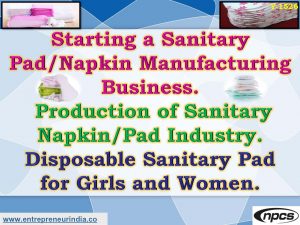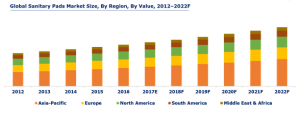Starting a Sanitary Pad Napkin Manufacturing Business

Starting a Sanitary Pad/Napkin Manufacturing Business. Production of Sanitary Napkin/Pad Industry. Disposable Sanitary Pad for Girls and Women.
A disposable absorbent pad used (as during menstruation) to absorb the uterine flow. Sanitary Napkin comes under Nonwoven fabrics which as a whole come under technical textile. Technical textiles are defined as textile materials and products used primarily for their technical performance and functional properties rather than their aesthetic or decorative characteristics.
Women in rural areas use re-usable cloth as sanitary pads and while that is eco-friendly, it is not so hygienic. While plastic-based menstrual hygiene products are available in abundance, it is advisable to switch to a natural, safer product that does not have any harmful chemicals or synthetics fibers.
An absorbent item worn by women, primarily to absorb menstrual blood, sanitary napkin is a widely used product. It is impermeable to liquids and consists of layers of quilted cotton fabrics and alternative layers of super absorbent polymers and plastics. In addition, fragrance and antibacterial agents are also included. Feminine hygiene (lady napkins) are hygiene absorbent products engineered to absorb and retain body fluid without causing any leakage. The user should always feel dry and comfortable. It consists of an absorbent pad sandwiched between two sheets of nonwoven fabric.
There are a number of factors owing to which sanitary napkins have emerged as one of the most popular option for menstrual management. As a result of economic development and encouraging market conditions, the majority of women worldwide are now able to afford sanitary napkins. Although this scenario varies in developed and developing regions. Diversification and innovations in the product design have facilitated the sanitary napkin market the developed regions.
India sanitary napkin market has significant profit potential. The demand for such products is stable purchases are recurring and not subject to normal business cycles. Historically the price of feminine hygiene products have been relatively expensive, but that is changing as small and large businesses enter the market and make an accessible lower-priced offering to a wider consumer base. In India the technology for sanitary napkins available by processing of raw cotton spinning and weaving to napkins. The processed cotton is purchased which is spinned and woven.
Market Outlook
The market displays an upward trend exhibiting some positive remarks about the variables in the market. Revenue growth is projected to be comparatively high in this period resulting into a higher production and consumption. The key players in the market have adopted strategic alliances for merger & acquisitions.
Geographical segmentation for sanitary napkin market comprises North America, South America, Europe, Asia-Pacific, Middle East and Africa. Asia-Pacific sanitary napkin market is likely to receive an overwhelming response due to rise in cancer cases owing to female hygiene. MEA market also gains a higher traction due to the rise in awareness about female mortality and effective use of sanitary pads. On the contrary, North American and European markets are expected to gain a significant rise in the global market due to the presence of manufacturing sector and innovative approach adopted by producers for product deliver the product.
Sanitary napkin market is driven by factors such as rise in awareness and innovations in product design, NGO activities for parental awareness pertaining to hygiene in menstrual periods and the effective use of sanitized napkins. In addition, increase in the demand for sanitized products in the developing regions trigger the market growth. Rise in mortality rate due to ovarian cancers also calls for sanitary napkins. However, low awareness, traditions and false beliefs pertaining to the use of sanitary pads are likely to disturb the market growth.
The Indian sanitary napkin market on the basis of type into disposable menstrual pads, cloth menstrual pads and biodegradable menstrual pads. Currently, disposable menstrual pads represent the largest product type, accounting for the majority of the total share. The market is also segmented on a regional basis, covering Maharashtra, Delhi NCR, Tamil Nadu, Karnataka, Gujarat and Others. Amongst these, Maharashtra is the leading market. Increasing hygiene and health concern among women and the rising popularity of sanitary napkin across the globe are major factors anticipated to fuel growth of the global sanitary napkin market.
Growing demand for a sanitary napkin in developed and developing countries and rising awareness about several health benefits associated with it such as easy to carry, safe, comfortable, hold more menstrual fluid, cost-effective, and others. These are other factors projected to support growth of the target market.
Global sanitary pads market stood at $ 18,426 million in 2016, and is projected to reach $ 26,215.23 million by 2022, exhibiting a CAGR of 6.07%, in value terms, on account of growing awareness among female towards hygiene, increasing disposable income and aggressive promotional activities. Moreover huge demand for reusable pads which are affordable and cost efficient is expected to positively influence global sanitary pads market in the coming years.
Global Sanitary Pads Market Size, By Regions, By Value, 2012-2022F

On the basis of type the global sanitary napkin market is segmented into menstrual pad and panty liner. Among these, menstrual represents the most popular product type. The market has further been analyzed on a regional basis, covering Asia-Pacific, Europe, North America, Latin America, and Middle East and Africa. Currently, Asia-Pacific represents the largest market, followed by Europe.
Key Players
Kimberly Clark Corporation, Hengan International Group Company Ltd, Johnson & Johnson Services, Inc, Unicharm Corporation, Kao Corporation, Svenska Cellulosa Aktiebolaget, Edgewell Personal Care Company, Ontex International N.V, Toruńskie Zakłady Materiałów Opatrunkowych S.A, Naty AB, Seventh Generation Inc, Drylock Technologies, Corman S.p.A, Hygienika Dystrybucja S.A, Napco Consumer Products Company Ltd, Bodywise (UK) Ltd, First Quality Enterprises Inc, Premier FMCG (Pty) Limited, Millie and More Pty Ltd, Kimberly-Clark Corporation, The Procter & Gamble, Edgewell Personal Care Company, Unicharm Corporation, Hengan International Group Co Ltd, Kao Corporation, Seventh Generation Inc, First Quality Enterprises Inc, Corman SpA, Ontex Group NV. • Carewell Hygiene Products Ltd. Centron Industrial Alliance Ltd. Diapers India Ltd. Godrej Hygiene Products Ltd. Gufic Biosciences Ltd. Johnson & Johnson Pvt. Ltd. Kimberly Clark Lever Pvt. Ltd
For More Details, Click Here:- https://niir.org/profile-project-reports/profiles/hygiene-products-essential-personal-hygiene-products-feminine-hygiene-products/z,,6c,46,a/index.html?_sort_by=default
